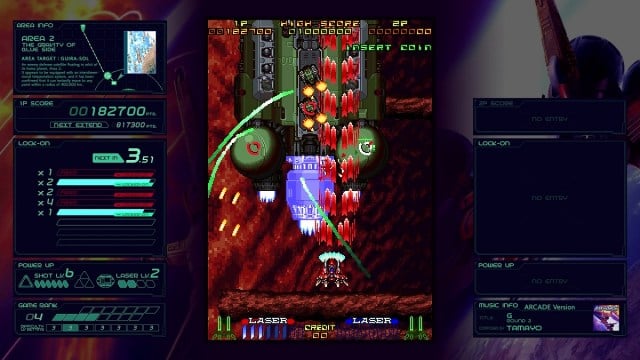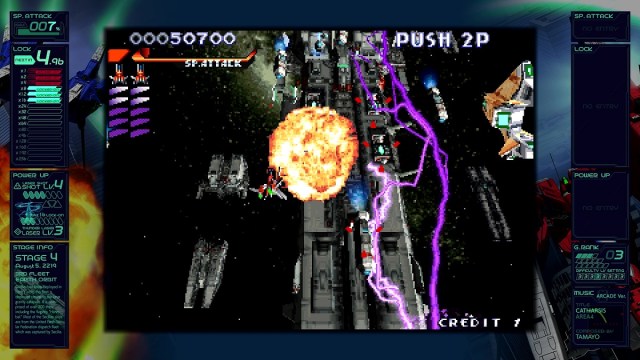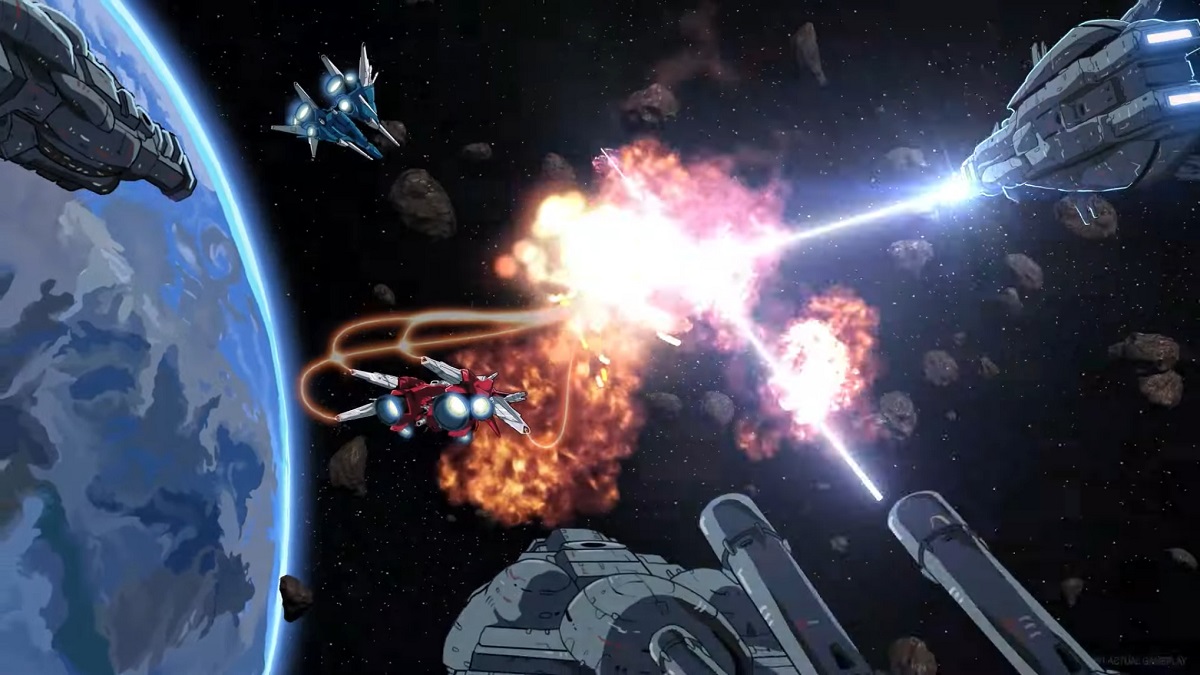Ray’zing the bar
If you’re only a casual or intermediate lover of scrolling shoot-’em-ups, it’s easy to drown in the deep end. The genre has been unfathomably popular in Japanese Game Centres for decades, so just about every publisher of arcade games at the time had multiple series going. So, you’ll have to excuse me if I haven’t played every game featured in the Ray’z Arcade Chronology. I mean, I’ve heard of them. Not that I could tell you when and where because the names RayForce, RayStorm, and RayCrisis are so laughably similar that I can’t keep them straight.
That’s okay. A lifetime of experience with the genre has given me ample framework to appreciate each of these games, and appreciate them I did.

Ray’z Arcade Chronology (Switch [Reviewed], PS4)
Developer: M2, Taito
Publisher: ININ Games
Released: June 30, 2023
MSRP: $49.99
Ray’z Arcade Chronology consists of three games in the “Ray” series. This is 1994’s RayForce, 1996’s RayStorm, and 1998’s RayCrisis. This is why you need to be careful with your nomenclature. We’re left with Ray’z to cover the whole series. Who’s Ray? I don’t know. Some guy who likes arcade shooters.
In any case, each of these titles is fantastic and brings something of their own to the table. RayForce is 2D, using a layer stacking technique to give the whole experience some 3D depth. RayStorm takes the series into actual 3D, which results in quite a ride. RayCrisis has the whole thing take place inside a supercomputer. This might sound lame, but there’s a feature where you’re given a specific route through the game, and your initials keep track of which ones you’ve cleared so you’re presented with a different series of levels each time you pick it back up.
The collection was overseen by M2, which should tell astute readers everything they need to hear. M2 is generally considered the gold standard when it comes to porting games, and scrolling shoot-’em-ups are their specific area of expertise. I probably don’t have to tell you they did an immaculate job with the Ray’z Arcade Chronology, but I will anyway: They did an immaculate job with the Ray’z Arcade Chronology.
Rather than just bare ports, each of the games gets a bunch of bells and whistles. You can play with the DIP switches to customize the experience. The borders are filled with more UI stats than you could even need (including one that tells you the name of the music track currently playing). You also get an HD version of both RayStorm and RayCrisis that literally does just that. It increases the resolution so you don’t get a pixellated look. I love the pixellated look, but maybe you don’t, weirdo.
RayCast
Anecdotally, I see RayForce as being the most highly respected of the bunch. It’s not hard to see why, as the sprite work is fantastic. It also has a smooth transition from level to level, making the whole thing seem continuous. It introduces the series staple of having a lock-on, which is necessary for hitting enemies that appear in the distance.
RayStorm is a lot of fun too. It might be my favorite in the bunch, but it’s harder to describe why. On paper, it really just sounds like RayForce in 3D, but while it loses the stylish transitions, it still feels like a great trip. It really knows how to make good use of the backgrounds to heighten the action without getting in the way.
On the other hand, I enjoyed RayCrisis far more than I thought I would. It feels more innovative than the other games, and gives more incentive to replaying and building up your skill. Not only do you get a different set of levels on each playthrough, but you’re also graded based on how well you do. You’re given an incentive to prevent enemies from simply exiting the screen unscathed. Considering most shoot-’em-ups are less than an hour long and replay value is usually just reducing continues used and increasing score, I appreciate something more tangible to help elevate it.
The downside is that, because it takes place in a computer, the levels aren’t quite as cohesive. They just sort of happen. In a way, the progression of RayCrisis is the antithesis of the one-take of RayForce. It’s not a deal breaker. It’s more like a compromise to get the sweet, sweet replay value.

RayTracing
Unfortunately, if you want to play the prototype for R-Gear, you need to order through Strictly Limited Games. R-Gear was initially in development as a sequel to RayForce that would have retained the 2D art style, but development instead moved to RayStorm’s full polygonal 3D. It’s just a prototype, and it only includes one level, but it would have been cool to have it as part of the digital version. Maybe I’ll just have to pony up for a physical copy. Goodness knows I enjoyed Ray’z Arcade Chronology more than enough to justify it.
Oh, hey, that leads us to this little summary paragraph. Ray’z Arcade Chronology is really good. It’s a great collection of great ports of great games. That’s it. No notes (aside from the ones already provided). If you haven’t played any of these games, you definitely owe it to yourself to check out the collection. If you have played them, this is just a great way to get all the titles together with some bells and whistles. I could scarcely ask for more.
[This review is based on a retail build of the game provided by the publisher.]














Published: Jun 30, 2023 02:00 pm